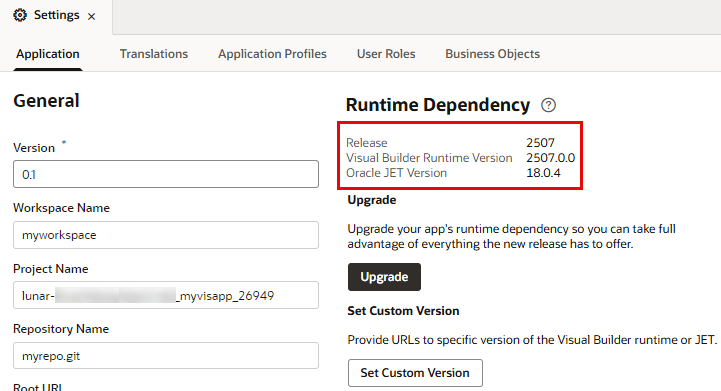24 Manage Runtime Dependencies for Visual Applications
In VB Studio, runtime dependencies refer to a set of client-side libraries that, along with the accompanying version of Oracle JET, determine features and other improvements available to your visual application, like what JET components you can use.
To see what the runtime dependencies are for your visual app, click Menu in the upper right corner, then select Settings:
- Release: The latest certified combination of Visual Builder Runtime and JET within a major release, such as
25.04,25.01, or24.10. - Visual Builder Runtime Version: A set of client-side libraries hosted on a Content Delivery Network (CDN). These libraries help the constituent files in your app talk to each other at runtime. For example, when you include a component (like a button) from the Component Palette in your app, the code for that component is stored in your app’s HTML file. If you then add an action chain to that button to navigate to a new page, the action chain code is stored in your app’s JSON metadata file. At runtime, the Visual Builder Runtime enables the HTML, JSON, and other dependent files in your app to communicate with each other, so that your app behaves as intended.
- Oracle JET Version: A JET release hosted on CDN. Each Visual Builder Runtime Version is certified to be compatible with one or more JET versions. If you’d like to see what’s in the latest JET release before deciding to upgrade, go to JET Release Notes and select the JET version stated on the Settings page.
Runtime dependencies are set for a visual application as a whole; you can’t set different versions for individual web apps within the visual app.
When VB Studio is upgraded to a new release, any new visual apps you create automatically use the latest Visual Builder Runtime and JET dependencies. However, apps created in earlier releases are not automatically updated—it’s up to you to decide when to upgrade, as long as you do so within a certain time period.
As a general rule, you can run a published VB Studio application built on the current runtime version and continue developing it on the four previous versions. Published apps can run indefinitely, but when working on apps in the Designer, you must consider support for the app's original runtime version. So for 25.10, for example, VB Studio supports not only the 25.10 runtime version, but also apps built with 25.07, 25.04, 25.01, and 24.10. Once 26.01 comes out, support for the 24.10 runtime version will drop off. In other words, when updating an app in the Designer, its runtime libraries are supported for about a year, after which you'll be prompted to upgrade. If you choose not to upgrade and republish, you run the risk that newer browser versions will break your published app. You also won’t be able to take advantage of any important security and performance improvements. For all of these reasons, we encourage you to build time into your development cycle to keep abreast of current changes, and to make sure you upgrade your app (you should version it first) before support for your current runtime version expires.